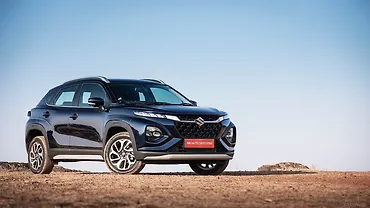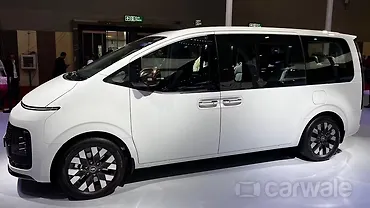
Maruti Suzuki has finally stepped inside the fierce mid-size SUV segment with the introduction of the Grand Vitara. It will be launched in the coming months along with its DNA cousin, the Toyota Urban Cruiser Hyryder. However, to make its mark, the SUV will have to fight it out with one of its strongest rivals, the Hyundai Creta. Let’s take a detailed look at the design, feature list, and engine specifications of the two.
Exterior

The Maruti Suzuki Grand Vitara is the first model by the carmaker to sport a split headlamp setup. While the three-pod LED DRLs look stylish, the massive front grille with oodles of chrome surround will certainly entice the buyers. Meanwhile, the Creta too, with its 2020 update, has got split headlamps with boomerang-shaped DRLs. Plus, the front grille has vertical and horizontal louvres finished in chrome.

As for the dimensions, the Grand Vitara with a length of 4,345mm is 45mm longer than the Creta. Moreover, at 1,795mm and 1,645mm, the Vitara is wider and taller, respectively, than the rival. However, the 2,610mm wheelbase of the Creta is 10mm more than the Grand Vitara’s 2,600mm. That said, both SUVs are fitted with 17-inch alloy wheels in the higher and top-spec variants.

When viewed from the side, the extra length is evident on the Grand Vitara and the SUV also gets dual-tone colour options, a floating roof design, and a larger rear quarter glass. The Creta, on the other hand, gets a contrasting colour on the C-pillar along with chrome door handles. The posterior of both the SUVs look unique. While the Creta gets vertically placed tail lamps and boot-mounted stop lamp, the Grand Vitara flaunts the sleek horizontal split tail lamps and bumper-mounted turn and reverse lights.

Interior

Starting with the dashboard layout, the Grand Vitara gets a dual-tone black and brown coloured theme with a gold insert at the centre. The nine-inch touchscreen infotainment is stacked atop the dashboard while the aircon vents are positioned below the unit. The instrument cluster is fully digital and the SUV is equipped with cooled front seats, a heads-up display, a 360-degree camera, a wireless smartphone charger, and a panoramic sunroof.

The Hyundai Creta follows a lighter black and beige shade and the larger 10.25-inch touchscreen system is integrated into the centre. In fact, the four-spoke flat-bottom steering wheel looks modern, and the higher variants also get an electric parking brake with an auto-hold function.
On the safety front, both vehicles are equipped with six airbags, all-four disc brakes, a tyre pressure monitoring system, hill-start assist, reverse parking sensors, and ISOFIX anchorage points in the rear seats.
Engine

The major differences between these mid-size SUVs are the powertrain options on offer. The Grand Vitara debuts the hybrid-powertrain option with a 1.5-litre petrol engine that has an output of 102bhp and 136.8Nm of torque. The transmission option includes a five-speed manual with an all-wheel-drive setup. Meanwhile, the automatic gearbox is a six-speed torque converter unit. On the flipside, there is no diesel engine on offer with the Grand Vitara.

The Hyundai Creta is available with three engine options – 1.5-litre petrol, a 1.4-litre turbo-petrol, and a 1.5-litre diesel engine. The former is tuned to produce 113bhp and 144Nm of torque and is mated to a six-speed manual and an iMT unit. However, none of the powertrains gets an all-wheel-drive or hybrid alternative.


![Hyundai Creta [2020-2023] Image Hyundai Creta [2020-2023] Image](https://imgd.aeplcdn.com/272x153/n/cw/ec/41564/hyundai-creta-right-front-three-quarter9.jpeg?q=80)
















![Hyundai Creta [2020-2023] Right Front Three Quarter Hyundai Creta [2020-2023] Right Front Three Quarter](https://imgd.aeplcdn.com/199x112/n/cw/ec/41564/hyundai-creta-right-front-three-quarter9.jpeg?q=80)
![Hyundai Creta [2020-2023] Right Front Three Quarter Hyundai Creta [2020-2023] Right Front Three Quarter](https://imgd.aeplcdn.com/199x112/n/cw/ec/41564/creta-exterior-right-front-three-quarter-2.jpeg?q=80)
![Hyundai Creta [2020-2023] Right Side View Hyundai Creta [2020-2023] Right Side View](https://imgd.aeplcdn.com/199x112/n/cw/ec/41564/creta-exterior-right-side-view.jpeg?q=80)
![Hyundai Creta [2020-2023] Dashboard Hyundai Creta [2020-2023] Dashboard](https://imgd.aeplcdn.com/199x112/n/cw/ec/41564/creta-interior-dashboard.jpeg?q=80)
![Hyundai Creta [2020-2023] Steering Wheel Hyundai Creta [2020-2023] Steering Wheel](https://imgd.aeplcdn.com/468x263/n/cw/ec/41564/creta-interior-steering-wheel.jpeg?q=80)

























